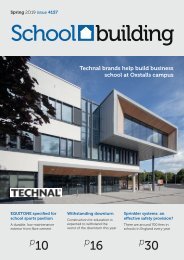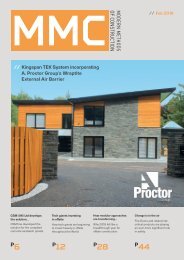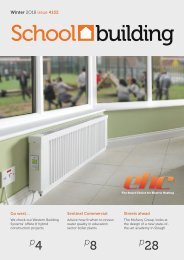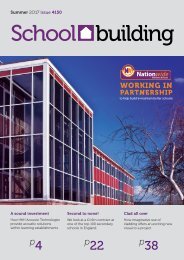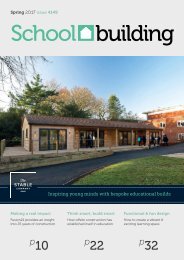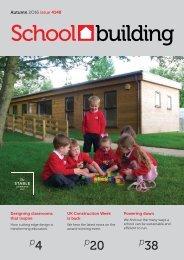SB 4156 32pp WEB
Create successful ePaper yourself
Turn your PDF publications into a flip-book with our unique Google optimized e-Paper software.
Case Study<br />
The crucial role of buildings in education<br />
We all know that the design of a building affect its occupants. Schools are no exception to this rule. Well-designed educational<br />
buildings not only improve the health wellbeing of students, but also their performance. In spite of this, a large number of British<br />
schools are in a state of neglect, falling into disrepair through nothing more than budgetary constraints. School Building<br />
Magazine Editor Joe Bradbury discusses:<br />
education, damp, leaky, outdated, asbestosridden<br />
schools are still prevalent. Too many<br />
pupils and teachers are struggling to learn<br />
and teach in conditions damaging to their<br />
health and education… and this needs to<br />
change.<br />
The Better Spaces for Learning report, which<br />
is still as relevant today as it was when<br />
published, revealed that the Government’s<br />
current programme of building new schools<br />
is inefficient – with a lack of flexibility to<br />
make the best possible use of resources, and<br />
little opportunity for school staff to input into<br />
the design of their own new buildings. RIBA<br />
continue to argue that the Government<br />
programme must be improved to guarantee<br />
better outcomes for our public money.<br />
Alandmark study from RIBA two years<br />
ago highlighted the urgent need for<br />
school refurbishment throughout the<br />
country. Using the largest ever analysis of<br />
primary and secondary school buildings in<br />
the UK, a nation-wide poll of teachers, and<br />
extensive engagement with school buildings<br />
experts, RIBA’s ‘Better Spaces for Learning’<br />
report made the case for an urgent review of<br />
the Government’s Education Funding<br />
Agency’s current school building<br />
programme. Alarmingly it revealed:<br />
• 1 in 5 teachers have considered quitting<br />
because of the wretched condition of the<br />
school buildings they have to teach in<br />
• The Government’s Education Funding<br />
Agency’s new school building programme is<br />
too rigid and is leading to waste and poor<br />
value for tax payers<br />
• Over 90% of teachers believe well-built and<br />
designed schools improve educational<br />
outcomes and pupil behaviour<br />
• Over-engineered schools, with<br />
Government-specified equipment that only<br />
costly consultants know how to operate, is<br />
costing £150 million per year which could<br />
have been avoided if schools were designed<br />
better.<br />
RIBA identified that good school design can<br />
reduce running and maintenance costs, in<br />
some cases by more than several times a<br />
teacher’s average salary a year; it could have<br />
prevented the English school estate from<br />
spending upwards of £150m annually on<br />
unnecessary operation and maintenance<br />
costs.<br />
None of this came as a shock to The<br />
Government, whose own research asserts<br />
that a mere 5% of the 60,000+ school<br />
buildings across the UK are performing as<br />
intended and operating efficiently.<br />
It seems that despite it now being universally<br />
accepted that a well-designed and<br />
maintained building is vital for a successful<br />
Commenting on this, RIBA President Jane<br />
Duncan said “This country is in the grip of the<br />
worst shortage of school places in living<br />
memory. Our report highlights the vital<br />
importance of school design and how it<br />
affects the general health and wellbeing of<br />
their users, our children and their teachers. As<br />
limited funding is available to deal with the<br />
growing problem, every penny spent on<br />
schools must deliver maximum value for<br />
money. Award winning well-designed,<br />
successful schools with happy pupils and<br />
productive staff like Burntwood School in<br />
London shouldn’t be the exception, they<br />
should be the standard.<br />
“How can we expect our children to compete<br />
with the world’s best when too many of our<br />
school buildings are substandard?<br />
Educational improvements resulting from the<br />
current programme of school building are<br />
not reaching the basic standards that British<br />
taxpayers and our economy expects. We<br />
need to do better for all of our children and<br />
their hardworking teachers. We urge the<br />
Government to review its programme of<br />
building new schools.”<br />
In summary<br />
The world is inherited by the young. In an<br />
increasingly competitive environment, we<br />
need to ensure we do everything within our<br />
power to educate our youth to the best of<br />
our ability – learning from our mistakes and<br />
improving on our own childhood education<br />
in the process. The built environment<br />
influences society that occupies it, so let’s<br />
make sure that influence is positive.<br />
Winter 2019 <strong>4156</strong> 31



